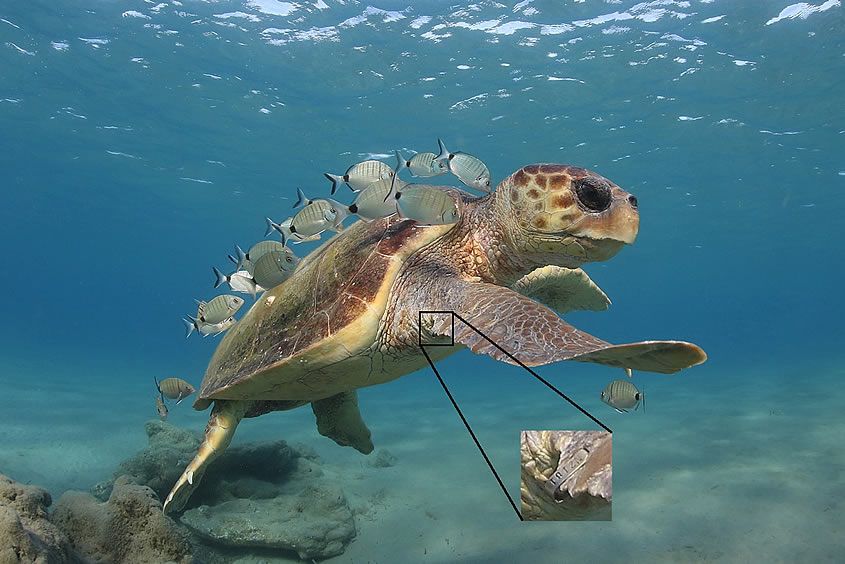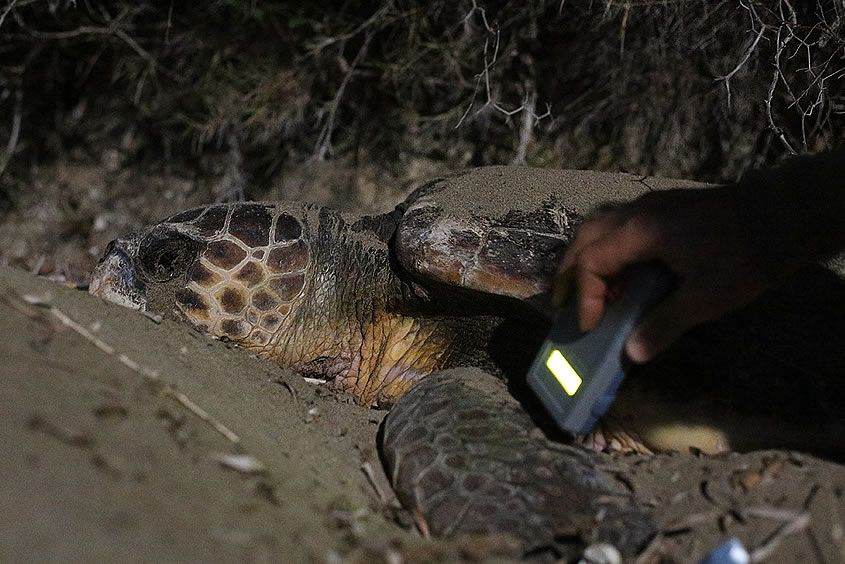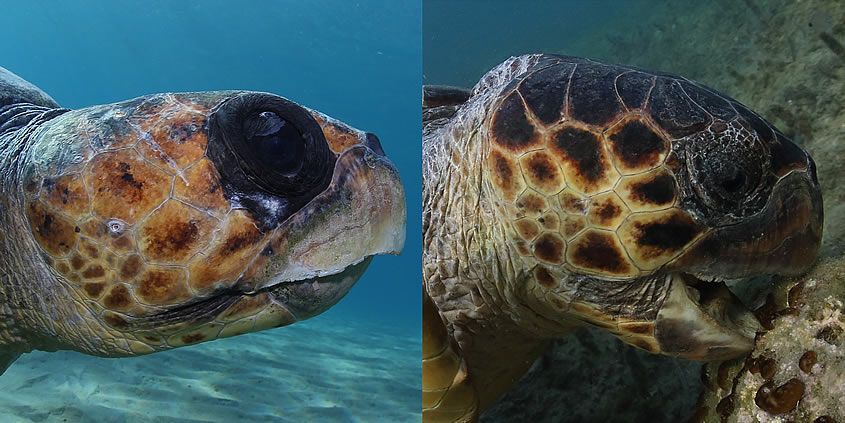How do we know that the turtle in the photo is unmistakably “Agisilaos”?
No doubt you have noticed the ease, with which sometimes we refer to specific sea turtles. It seems natural to give the turtles names in the Rescue Centre, but what about who is who at sea? The answer lies with the “tagging” processes that are in use in ARCHELON projects and also worldwide. Below you will find more on info on the this subject.
Giving an identity to wild animals is a fundamental way to study their populations. This has been the case for sea turtle populations since the very start of their conservation back in the 50s. In fact one has to think hard to find sea turtle studies where the identification of individuals through some "tagging" process does not play any role in one way or another. For instance by tagging nesting females one can follow their reproductive history for as long as these females are encountered at the nesting beaches, as well as to record their whereabouts in other areas and seasons. Growth rates of individuals can also be monitored at both nesting and foraging grounds, in the latter case via the so-called mark-recapture studies, where individuals are caught, tagged and released in a few minutes.
Which are the different ways that one can "tag" a turtle? The most popular method that has been used for more than half a century is via metal or plastic tags that are placed to the turtles' flippers. These tags bear a unique identification number that can be easily recorded by anyone who encounters the turtle. The method is cost effective, does not require any previous experience or equipment to "read" the tag but on the other hand "tag loss" that is, the fact that these tags often do not remain in place for ever, remains a challenge.

On the other hand, PIT tags (Passive Integrated Transponder) provide a more reliable solution. These are small circuits that are inside a glass capsule that has the size of a rice grain. They are inserted into the turtle's arm with a sterile injection. A special scanner is then able to read the tag which provides a unique ID code. PIT tags are considered to be more permanent than traditional flipper tags. However one drawback is the increased cost per tag as well as the need for a specific scanning equipment necessary to read it.

Another possibility is photo identification, where one exploits the fact that the "scales" (scutes) of the head form a pattern unique for every turtle, like the human fingerprints. This technique has specially come to rise after the advances in digital photography. This form of tagging is permanent as is the scute pattern throughout the sea turtle's life. It is cost effective and requires no handling of the animal since a simple photograph of good quality suffices. However, the matching process, that is examining whether a newly photographed individual exists in a given database, is often time consuming. Nevertheless, automated matching algorithms are constantly being developed and improved, often reducing a lot the time required for the matching process.

Finally, genetic tagging has been recently used successfully, with a prominent example that of the loggerhead population of the south east United States. For example there, an egg from every clutch is collected (or skin sample in other projects), and the genetic profile of the mother loggerhead is extracted and stored in a database. Hence in that case, it is not even necessary to encounter the animal in order to tag it. This has provided some unique insights into the nesting dynamics of the studied populations. In certain cases, mother-daughter or sibling relationships are identified opening new horizons in answering some important demographic questions, like for example age at sexual maturity. However, the increased cost as well as the requirement for highly specialized personnel limits these methods to only a few parts of the world.

ARCHELON has been tagging nesting females at the most important nesting sites of Greece since the beginning of the 80's with thousands of individuals tagged so far. Also ARCHELON has been PIT-tagging nesting females in Kyparissia Bay since 2005 and in Zakynthos. Furthermore, males as well as immature turtles are tagged in the mark-recapture project of Amvrakikos bay. For that, metal and PIT tags are typically used and occasionally photo identification as well.
(text and photos by Kostas Papafitsoros)
The victim was a sea turtle everyone was trying to see and admire
ARCHELON’s Lakonikos bay project has a big heart!
RECENT NEWS
- OUR NEWS08/12/2025
Applications Now Open for 2026 ARCHELON Field Leaders Posts!
ARCHELON is pleased to announce that applications are now open for the 2026 Field Leader positions across all nesting projects (applications open until January 31st).
- OUR NEWS05/12/2025
Saving Sea Turtles Together – A Tribute to Volunteers
On Volunteer Day, we take a moment to celebrate all those who came from near and far, put on the blue T-shirt, and embraced this important responsibility.
- OUR NEWS01/12/2025
Laganas Bay, Zakynthos: Successful Loggerhead Reproduction, Ongoing Habitat Problems
On the beaches of the Zakynthos National Marine Park, around 2,155 turtle nests successfully hatched thanks to active protection measures, but human pressures on coastal and marine habitats continue.
- OUR NEWS26/11/2025
A Second Chance: Two Loggerhead Sea Turtles Return to the Sea Thanks to Dedicated Rescues
This summer, two adult loggerhead sea turtles, ‘Aktaia’ and ‘Herbert’, arrived at ARCHELON’s Sea Turtle Rescue Centre needing urgent help after sustaining severe head injuries.
- OUR NEWS11/11/2025
Volunteering Projects 2026: Sea Turtles Need You, the Planet Needs Us!
ARCHELON welcomes volunteers from all over the world and of all ages (over 18) and no prior experience is required! If you speak English, are at least 18 years old, and are in good physical condition, you can do this!
- OUR NEWS10/11/2025
Outstanding Recognition for ARCHELON at the Effective Dialogue Conference 2025
On Thursday, November 6, 2025, ARCHELON received an honorary distinction for its substantial contribution to effective dialogue on sustainability, social responsibility, and the environment
- OUR NEWS06/11/2025
6th Year of Online Tours: The sea turtles are traveling across Greece once again!
Students from every corner of the country, as well as from international schools, have the opportunity to learn up close about the lives of the turtles cared for at the Sea Turtle Rescue Centre in Glyfada, Attica, and to discover how rescue efforts impact the marine world.
- OUR NEWS31/10/2025
The lecture turned into reality: A real turtle rescue for the students from Kallithea!
The students spotted a sea turtle floating in the water right after their educational tour of the ARCHELON Rescue Centre and immediately notified the rescuers.
- OUR NEWS24/10/2025
LIFE MareNatura Documentary Premier
From seabird monitoring and genetic sampling, to unique underwater footage of marine mammals, the testimonies of scientists bring to life the hidden stories of the sea.
- OUR NEWS23/10/2025
ARCHELON participates in the "Science Festival 2025 – The Voice of the Ocean"
The French Institute of Greece is organizing a celebration from 10 to 27 November 2025 dedicated to science and the ocean! World premiere of the LIFE MareNatura documentary on November 13th.
- OUR NEWS22/10/2025
Kyparissia Bay: ARCHELON Records 6,100 Nests and Calls on the State to Immediately Implement the National Action Plan for the Loggerhead
In 2025 approximately 6,100 nests were recorded, marking a 74% increase compared to the average of the previous 12 years!
- OUR NEWS10/10/2025
We bid farewell to a devoted environmentalist and friend, Yiannis Roussopoulos.
- OUR NEWS02/10/2025
Jane Goodall’s words still warm our hearts
Thank you, Dr. Goodall, for all that you have taught us and for the life example you have left behind.
- OUR NEWS29/09/2025
Turtles, Dolphins, and Birds: Local Communities and Scientists come together for the future of Amvrakikos Gulf
A one-day conference held on Wednesday, September 24, in Menidi, Amfilochia, united the voice of the local community with leading scientists and environmental organizations for Amvrakikos Gulf.
- OUR NEWS26/09/2025
Biologists from the 'LIFE ADAPTS' project send their message to the community


